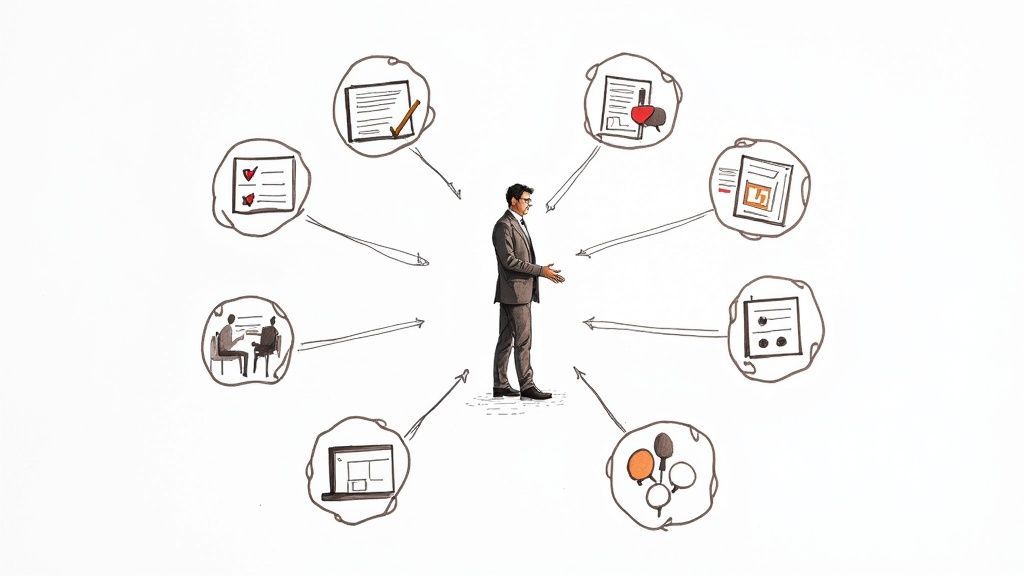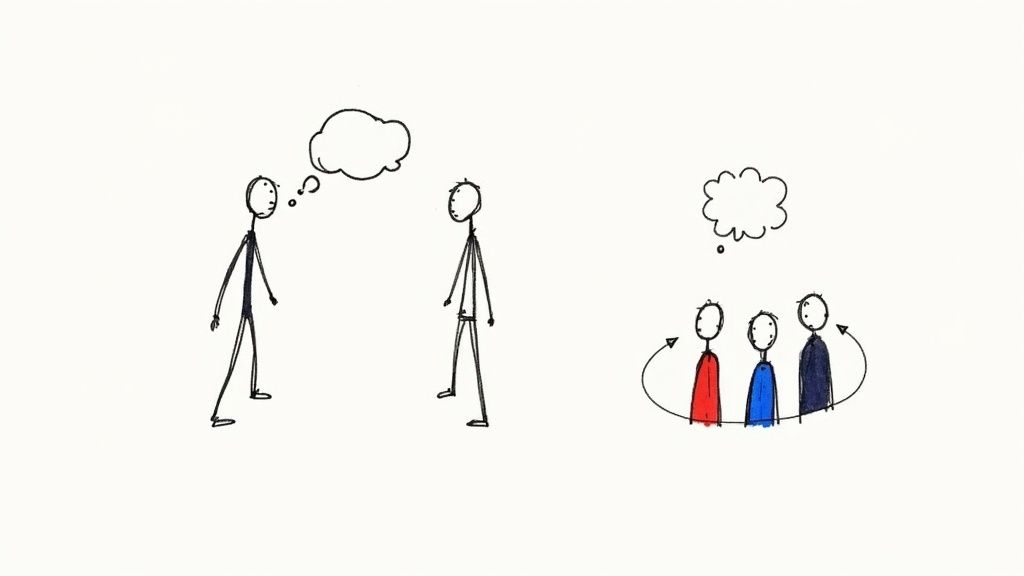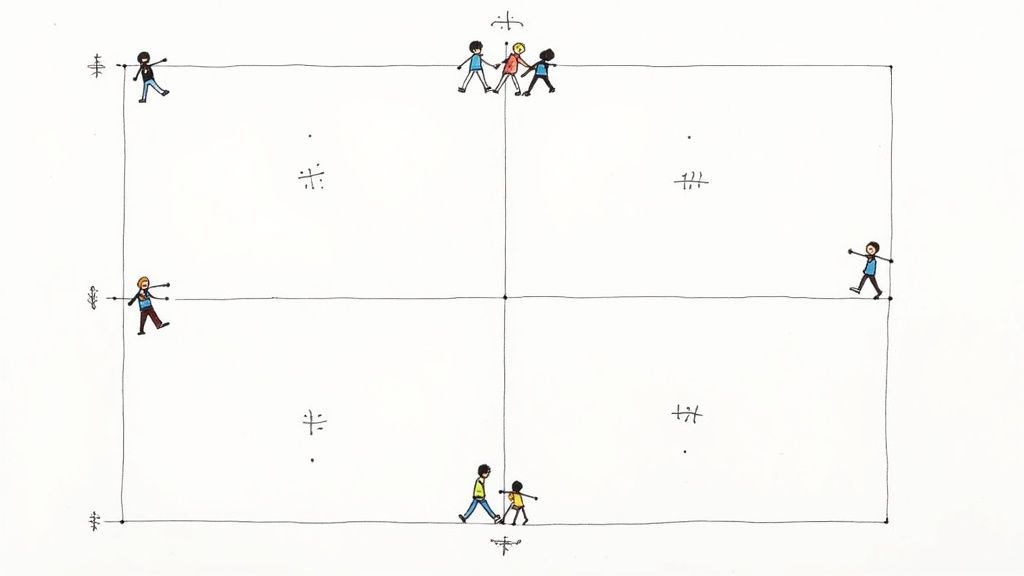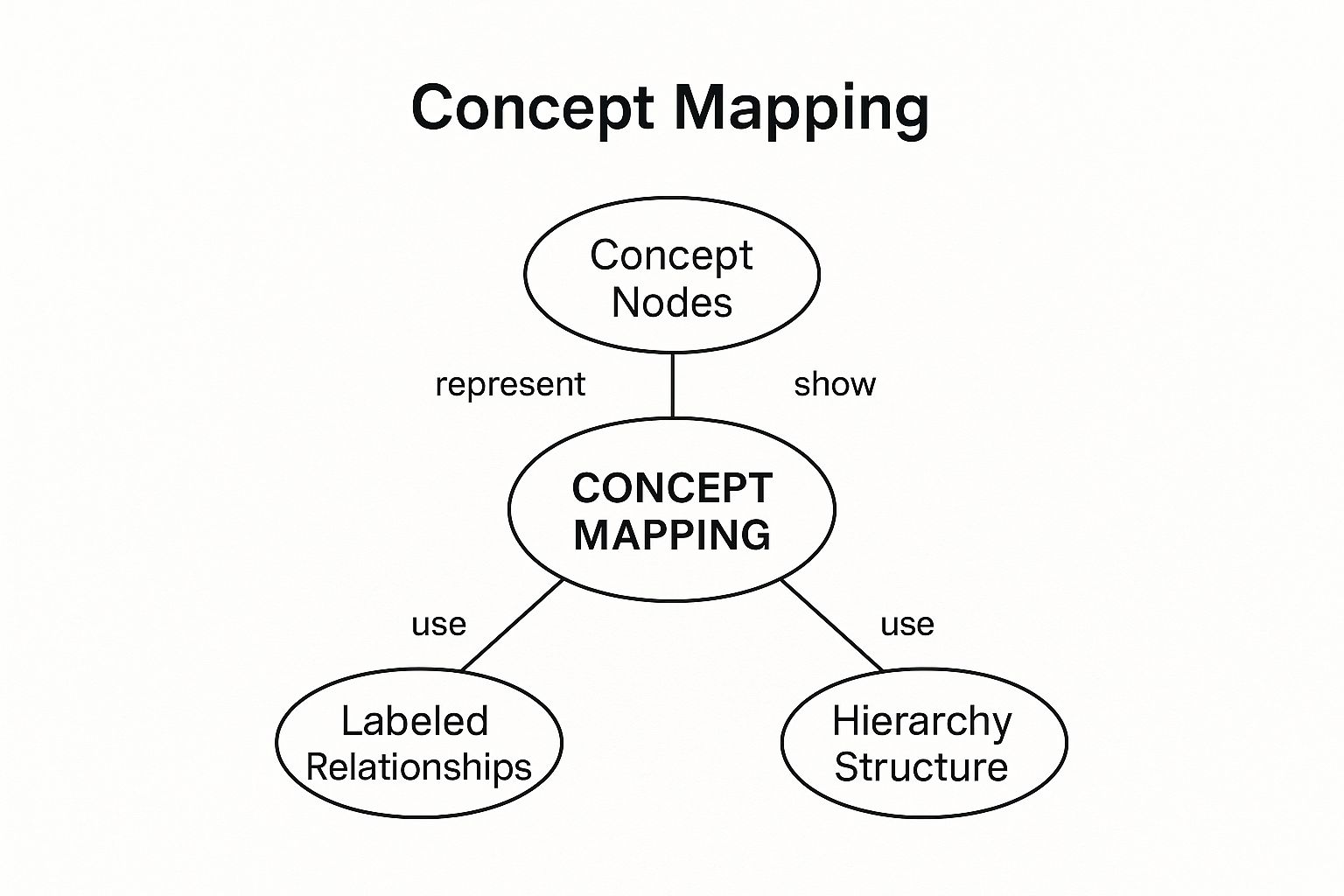
Top 8 Formative Assessment Techniques for Corporate Training
In the fast-paced world of corporate learning and development, 'train and hope' is no longer a viable strategy. The real challenge isn't just delivering content; it's ensuring that content sticks, skills are developed, and performance improves. This is where the power of a continuous feedback loop comes into play, creating a responsive training environment that adapts to employee needs.
Formative assessment techniques, traditionally used in academia, are now being reimagined for the corporate world to provide real-time insights into employee comprehension and skill application. By gathering this data during the learning process, L&D professionals can pinpoint misunderstandings and adjust their approach immediately, rather than waiting for a final, often ineffective, summative evaluation. For those looking to implement modern approaches, exploring advanced tools for real-time feedback customization can significantly enhance your training's responsiveness.
This article moves beyond theory to provide actionable strategies tailored for corporate trainers and L&D managers. We will explore eight specific formative assessment techniques that you can implement immediately to gauge understanding, identify knowledge gaps, and adapt your training on the fly. We'll also demonstrate how modern tools, like the Mindstamp interactive video platform, can supercharge these methods, turning passive video content into dynamic, data-rich learning experiences that drive real business outcomes.
1. Exit Tickets: The 3-Minute Pulse Check
Exit Tickets are a classic formative assessment technique that adapts brilliantly to corporate training and digital learning environments. They serve as a quick, low-stakes diagnostic tool at the conclusion of a training module, webinar, or session. The goal is to gather immediate feedback on employee comprehension and session effectiveness.
By asking participants to respond to 2-3 focused prompts before they "exit" the learning experience, you get an invaluable snapshot of what they absorbed. This isn't a formal quiz; it's a pulse check to identify key takeaways, points of confusion, and areas needing reinforcement.
How to Implement Exit Tickets
This technique provides immediate, actionable data. Instead of waiting for post-course surveys, you can adjust your strategy in near real-time, tailoring follow-up content or the next day’s agenda to address specific skill gaps.
- Prompt with Purpose: Design questions that reveal understanding, not just recall. Avoid simple yes/no questions.
- Keep it Brief: The process should take no more than three minutes. The low time commitment encourages higher participation and more candid responses.
- Analyze and Act: The real power of this technique lies in reviewing the responses promptly. Look for patterns in what employees found clear versus what they found confusing.
Key Insight: The "muddiest point" question is one of the most effective formative assessment techniques you can use. Asking "What was the most confusing concept from today's session?" gives you a precise roadmap for where to focus your clarification efforts.
Digital-First Example with Mindstamp
For asynchronous video training, embed an Exit Ticket directly into your content using an interactive video platform like Mindstamp. At the end of a module on a new software feature, configure a non-skippable interaction with these questions:
- What is the single most impactful way this new feature will change your workflow? (Assesses application)
- Describe one step in the process you're still unsure about. (Identifies confusion)
- What additional support would help you master this feature? (Gathers feedback for future content)
This approach captures crucial data at the peak moment of learning, ensuring your training is not just delivered, but truly understood and ready to be applied.
2. Think-Pair-Share: Collaborative Problem-Solving
Think-Pair-Share is a highly effective collaborative learning strategy that is perfect for the corporate training environment. It’s an active process designed to move employees from silent reflection to vocalizing their ideas in a structured, low-pressure environment. The technique involves three distinct steps: participants first think independently about a prompt, then discuss their thoughts with a partner, and finally, share their synthesized ideas with the larger group.
This method transforms passive listeners into active participants, making it an excellent formative assessment technique for gauging understanding during live workshops, virtual training sessions, or team meetings. It allows facilitators to observe discussions, listen for comprehension, and identify misconceptions in real time.

How to Implement Think-Pair-Share
This strategy is powerful because it gives every employee a voice, especially those who might be hesitant to speak in a larger group. It builds confidence and encourages deeper processing of the training material by requiring learners to articulate their thoughts to a peer.
- Pose a Compelling Prompt: Use open-ended, business-relevant questions. For a sales training, ask: "Think of a potential client objection to our new pricing model."
- Structure the Time: Be explicit about timing. For instance: "Take 60 seconds to think quietly, then you’ll have two minutes to discuss with your partner."
- Facilitate and Observe: During the "Pair" phase, circulate through the room (or breakout rooms) to listen in. This is your prime opportunity to assess understanding and spot common challenges.
Key Insight: The "Pair" stage is the most critical part of this formative assessment technique. It creates a safe space for employees to test their ideas and receive immediate peer feedback before presenting to the entire group, revealing authentic thought processes you might not otherwise see.
Digital-First Example with Mindstamp
You can adapt Think-Pair-Share for asynchronous video training to foster a sense of community and collaborative learning. In a Mindstamp video about new compliance procedures, embed an interactive prompt midway through:
- Think (Comment): A text-based question asks, "Based on this new policy, what is one potential compliance risk in your daily workflow?" Employees submit their answer as a time-stamped comment.
- Pair (Review): After submitting, they see comments from colleagues. The next instruction says, "Review a coworker's comment and reply with a suggestion to mitigate their stated risk."
- Share (Summary): Later in the video, or in a follow-up email, you can showcase a few of the most insightful risk/mitigation pairings, effectively "sharing" the best ideas with the entire cohort.
This approach transforms solo viewing into a dynamic, interactive dialogue, allowing you to gauge how well your team can apply complex business concepts. Discover more strategies for turning passive viewing into engagement by exploring these examples of active learning on mindstamp.com.
3. Kahoot! and Digital Quizzes: Energizing Knowledge Checks
Digital quiz platforms like Kahoot!, Mentimeter, and Quizizz transform routine knowledge checks into dynamic, engaging events. These game-based tools allow you to create interactive quizzes where employees respond in real-time using their own devices. This approach provides immediate feedback to both the participant and the facilitator, turning formative assessment into a competitive and motivating activity.
In corporate training, these tools break the monotony of traditional presentations. They inject energy into a session while simultaneously revealing comprehension gaps on critical topics, from new compliance protocols to product features. The real-time leaderboard and instant results create a low-stakes, high-engagement environment where employees are motivated to participate actively.
How to Implement Digital Quizzes
This technique is excellent for identifying misunderstandings as they happen, allowing for immediate clarification before moving on. The data gathered provides a clear picture of group-wide comprehension and pinpoints individuals who may need extra support.
- Vary Your Timing: Use a quick quiz to activate prior knowledge at the beginning of a session, check understanding mid-module, or review key takeaways at the end.
- Balance Speed and Substance: While gamification thrives on speed, ensure question timers allow for genuine thought, not just quick reflexes. The goal is accurate assessment, not just a race.
- Review and Reinforce: Use the instant results to facilitate a discussion. Address common incorrect answers immediately to correct misconceptions before they become ingrained.
Key Insight: The true power of digital quizzing in a corporate setting is its ability to make mandatory training feel like a voluntary, engaging challenge. It shifts the dynamic from passive reception to active participation and friendly competition.
Digital-First Example with Mindstamp
While live quizzes are effective, you can build this same engaging assessment directly into asynchronous training videos with Mindstamp. For a sales team onboarding video about a new CRM, you can embed a scored quiz interaction to check for understanding of key processes.
- Question: "Which three fields are mandatory when creating a new lead record?" (Multiple choice, multi-select)
- Question: "True or False: A deal can be moved to the 'Closed-Won' stage without an attached contract." (True/False)
- Question: "What is the first step you should take after a discovery call?" (Multiple choice)
This creates a robust, self-paced formative assessment technique within your training content. Employees receive instant feedback, and managers can track performance data to identify where the team needs more coaching. You can learn more about creating an interactive video quiz to see how this can be applied.
4. One-Minute Papers: The Focused Feedback Snapshot
One-Minute Papers are a powerful formative assessment technique where employees take sixty seconds to reflect on and summarize a learning experience. This brief, focused writing task, often completed at the end of a training session, asks participants to synthesize their understanding, pinpoint lingering questions, and articulate their main takeaways. It's a highly efficient method for gathering candid feedback on instructional clarity.
While similar to Exit Tickets, the One-Minute Paper emphasizes synthesis and reflection over direct questioning. By asking "What was the most important concept you learned?" or "What single question remains unanswered for you?", you get a high-level view of how effectively your key messages landed and where comprehension breakdowns occurred, all within a minimal time frame.
How to Implement One-Minute Papers
This technique is excellent for gauging the immediate impact of your training content and identifying common misconceptions before they become ingrained. It fosters a culture of reflection and metacognition, encouraging employees to think about their own learning process.
- Vary Your Prompts: Keep the exercise fresh by alternating between prompts focused on content ("Summarize the core idea of this module") and process ("Describe how you will apply this skill tomorrow").
- Frame Confusion as a Tool: Create a psychologically safe environment where employees feel comfortable admitting what's unclear. Position their questions as valuable data that helps improve the training for everyone.
- Analyze for Themes: The goal isn't to respond to every individual paper. Instead, review the responses to identify patterns and themes, which you can then address at the start of the next session or in a follow-up communication.
Key Insight: The true power of the One-Minute Paper lies in its brevity. The time constraint forces employees to bypass overthinking and provide an honest, gut-level response, giving you a more authentic measure of their understanding and confidence.
Digital-First Example with Mindstamp
Leverage interactive video to automate the collection of this valuable feedback. In a Mindstamp training video about a new compliance protocol, place a timed, open-ended question interaction just before the concluding slide.
- Set a 60-second timer on the interaction to simulate the "one-minute" constraint.
- Prompt 1: What is the single most critical compliance risk we addressed today? (Assesses prioritization)
- Prompt 2: What is one aspect of this protocol that still seems ambiguous to you? (Identifies knowledge gaps)
By embedding this formative assessment technique directly into your video, you capture precise, in-the-moment feedback. This data helps you refine not just future iterations of the course, but also supporting documentation and job aids.
5. Four Corners: Making Alignment Visible
Four Corners is a kinesthetic formative assessment technique that gets employees out of their seats and makes their perspectives instantly visible. It’s an engaging way to gauge understanding, opinions, and confidence levels across a team. In this strategy, different corners of the room are assigned specific meanings or answers, and participants move to the corner that best represents their position.

This method transforms a passive audience into active participants. By asking team members to physically commit to a stance on a new policy, a strategic decision, or their confidence in a new process, you create a dynamic, visual representation of group sentiment. It’s an excellent tool for sparking discussion and uncovering the "why" behind people's choices.
How to Implement Four Corners
This technique is powerful for live, in-person training as it breaks up long periods of sitting and encourages peer-to-peer interaction. The physical movement and subsequent discussion help solidify learning and reveal nuances in team alignment that a simple poll might miss.
- Label with Clarity: Clearly designate each corner with a sign representing an option (e.g., Strongly Agree, Agree, Disagree, Strongly Disagree; or confidence levels like "Expert," "Comfortable," "Need More Practice," "Just Starting").
- Prompt for Justification: Once participants have moved, ask them to discuss their reasoning with others in their corner. This peer discussion reinforces their thinking.
- Share and Re-evaluate: Invite a representative from each corner to share a summary of their group's reasoning. You can even allow participants to change corners if another group's argument persuades them.
Key Insight: Using Four Corners to gauge confidence levels before a technical skills practice is incredibly effective. It visually separates experts from novices, allowing you to create targeted breakout groups or pair employees for peer-to-peer mentoring on the spot.
Digital-First Example with Mindstamp
To adapt this technique for remote or asynchronous training, use Mindstamp’s clickable hotspots or button interactions. In a video training module covering a new compliance protocol, overlay four distinct clickable areas onto the screen, each labeled with a stance:
- Fully Compliant: "Our team already follows this process."
- Mostly Compliant: "We do most of this but need minor adjustments."
- Partially Compliant: "We need to make significant changes to align."
- Non-Compliant: "This is a completely new process for us."
Configure each button to jump to a different point in the video with tailored follow-up information, resources, or a prompt to connect with a compliance officer. This digital adaptation provides segmented, relevant feedback based on the team's self-assessed starting point.
6. Peer Assessment and Feedback: Cultivating a Collaborative Learning Culture
Peer Assessment and Feedback transforms employees from passive recipients of information into active participants in the evaluation process. This formative assessment technique empowers team members to evaluate their colleagues' work against established criteria, fostering a deeper understanding of quality standards and developing critical thinking skills. It's a powerful method for scaling feedback and building a culture of continuous improvement.
Instead of a top-down review, this approach creates a dynamic feedback loop where team members learn from each other. By analyzing a peer's work, an employee must first internalize the standards for success, which reinforces their own knowledge. They gain new perspectives and learn to articulate constructive criticism, a crucial skill in any corporate environment.
How to Implement Peer Assessment and Feedback
This technique builds accountability and collaborative problem-solving. It's particularly effective for complex skills like project management, sales pitches, or software development, where multiple valid approaches exist.
- Provide Clear Guardrails: Equip employees with specific rubrics, checklists, or guided questions. Structure is essential for ensuring feedback is constructive and aligned with learning objectives, not just subjective opinion.
- Model the Process: Before the first peer review, demonstrate what excellent feedback looks like. Use an example to model how to provide comments that are specific, kind, and helpful.
- Focus on the Work, Not the Person: Train participants to critique the project, presentation, or process, not the individual. This depersonalizes the feedback and maintains a psychologically safe learning environment.
Key Insight: The greatest benefit of peer assessment is often for the person giving the feedback. To evaluate a colleague's work effectively, an employee must first master the material and internalize the success criteria, leading to a profound reinforcement of their own learning.
Digital-First Example with Mindstamp
Use interactive video to facilitate asynchronous peer reviews of practical skills. For a sales training program, have each team member record a two-minute practice pitch for a new product. Upload these videos to a Mindstamp Series.
Next, create a peer review "assignment" where each rep must watch two of their colleagues' pitches. At a key point in each video, embed a guided feedback interaction using a series of questions:
- Based on the rubric, what was the single strongest element of this pitch? (Identifies strengths)
- Which part of the value proposition was least clear? Suggest a specific wording change. (Promotes constructive, actionable critique)
- On a scale of 1-5, how confident are you that the customer's primary pain point was addressed? (Gathers quantitative data)
This method allows for scalable, structured, and consistent peer-to-peer coaching, providing every team member with valuable, diverse feedback they can immediately apply.
7. Concept Mapping: Visualizing Employee Knowledge Structures
Concept Mapping is a powerful visual formative assessment technique where employees create diagrams to illustrate the relationships between concepts. By connecting ideas (nodes) with labeled lines (relationships), participants build a visible representation of their mental models. This makes it an exceptional tool for trainers to diagnose how well employees are integrating complex information and organizing new knowledge.
Unlike a simple quiz that tests recall, a concept map reveals the depth and structure of an employee's understanding. It exposes sophisticated connections, identifies critical misconceptions, and highlights knowledge gaps. In a corporate training setting, this technique is invaluable for assessing comprehension of complex systems, processes, or strategic frameworks.
How to Implement Concept Mapping
This technique helps you move beyond "what" employees know to "how" they connect that knowledge, providing a richer, more nuanced understanding of their cognitive progress. It's particularly useful for topics with many interconnected parts, like a new sales methodology or a complex compliance procedure.
- Provide a Clear Focus: Give employees a central question or a core concept to build their map around. You can also provide a starter list of key terms to include.
- Model the Process: The first time, build a simple concept map with the group to demonstrate how to link concepts with descriptive action words (e.g., "leads to," "is composed of," "influences").
- Analyze the Connections: The most important data comes from the labeled lines between concepts. Are the relationships accurate? Are they superficial or insightful? This is where true understanding is revealed.
Key Insight: The true power of concept mapping as a formative assessment technique lies in the "linking phrases." An employee who connects "New Software" to "Increased Efficiency" with the phrase "automates manual tasks" shows a much deeper level of understanding than one who simply draws a line.
The following infographic illustrates the core components that make up an effective concept map.

As shown, the technique relies on the interplay between concepts, the relationships that connect them, and an organized structure to create a coherent picture of understanding.
Digital-First Example with Mindstamp
Concept mapping can be integrated into asynchronous training to assess understanding of a recorded webinar or a complex product tutorial. After a video module on your company's new market-entry strategy, use Mindstamp to embed a "File Upload" interaction.
Instruct employees to:
- Download a basic template or use a free online tool (like Coggle or Lucidchart).
- Create a concept map that connects the key components of the strategy: Target Demographics, Core Messaging, Channel Partners, and Success Metrics.
- Upload a screenshot or PDF of their completed map directly into the video player.
This allows you to collect and review each employee's strategic understanding, providing personalized feedback on how they are connecting the dots of a complex business initiative.
8. Observational Assessment and Anecdotal Records
Observational Assessment is a powerful formative assessment technique where facilitators systematically watch and document employee behaviors, problem-solving approaches, and skill application in real-time. This method moves beyond written tests, capturing authentic evidence of competency as employees engage with training materials or perform tasks in a simulated or live environment.
Instead of relying solely on final outputs, this technique uses anecdotal records, checklists, or rubrics to track the process of learning. It is particularly valuable for assessing complex, hands-on skills like leadership, sales negotiations, or technical troubleshooting, where the "how" is just as important as the "what."
How to Implement Observational Assessment
This technique is ideal for workshops, role-playing scenarios, and on-the-job training. It allows facilitators to provide specific, in-the-moment feedback that is directly tied to an employee’s actions, making it highly relevant and impactful for skill development.
- Define Clear Criteria: Before observing, establish what success looks like. Use a rubric or checklist with specific, observable behaviors related to the learning objectives.
- Focus on a Few Employees: To ensure quality observations, concentrate on a small group of participants at a time. Create a rotation schedule to cover everyone over the course of a training program.
- Document Efficiently: Use a digital tool or a simple clipboard to jot down notes. Develop a shorthand system to quickly capture key actions, quotes, and behaviors.
Key Insight: The true value of observational assessment is in tracking progress over time. Dated anecdotal records provide a compelling narrative of an employee's growth, identifying both persistent challenges and breakthrough moments that a single test would miss.
Digital-First Example with Mindstamp
Observational assessment can be adapted for asynchronous training, especially for procedural or software skills. Using Mindstamp, you can prompt employees to record themselves performing a task and submit the video for review.
For a new-hire training on a complex CRM workflow, embed an interaction that asks employees to:
- Record your screen and voice as you complete the "New Lead Qualification" process in the sandbox environment. (Assesses procedural fluency)
- Verbally explain your reasoning for each step you take. (Reveals thought process)
- Submit your video for manager review. (Captures performance for feedback)
This creates a permanent, reviewable record of an employee's practical skills. The manager can then use Mindstamp’s commenting feature to provide time-stamped, specific feedback directly on the video, turning a passive learning module into an active coaching opportunity.
Formative Assessment Techniques Comparison
From Insight to Impact: Making Your Training Data Actionable
We've explored a powerful suite of formative assessment techniques, from the quick pulse-check of a One-Minute Paper to the collaborative depth of Peer Assessment. Each method, whether it's the dynamic energy of Four Corners or the visual clarity of Concept Mapping, offers a unique lens through which to view employee comprehension and engagement. However, the true value of these strategies is not found in their execution alone, but in the deliberate action that follows.
The data gathered from these assessments is the raw material for a more agile, responsive, and effective learning and development program. The goal is never simply to collect answers; it's to uncover insights. These insights empower you to transform your training initiatives from static, one-way broadcasts into dynamic, responsive conversations that drive real-world performance.
Turning Feedback into Forward Momentum
Mastering these formative assessment techniques means embracing a culture of continuous improvement. Instead of waiting for a final, summative evaluation to reveal skill gaps, you can identify and address them in real-time.
Think of the feedback you receive not as a final grade, but as a guidepost.
- Low scores on an interactive video quiz? This isn't a failure. It's a clear signal to revisit a complex topic, add supplementary resources, or break down the concept into more digestible microlearning modules.
- Observational notes showing hesitation with a new software? This is an opportunity to provide targeted, one-on-one coaching or create a short tutorial video addressing that specific workflow.
- Exit ticket responses revealing confusion about a new policy? This is your chance to clarify messaging and prevent costly misunderstandings before they take root.
By embedding these frequent, low-stakes feedback loops into your training architecture, you create a psychologically safe environment where employees feel comfortable indicating what they don't know. This data-driven approach allows you to pivot your instructional strategy, ensuring that every training dollar and every learning hour is invested wisely, directly contributing to a more skilled and confident workforce.
The Strategic Advantage of Actionable Data
Ultimately, integrating formative assessment techniques into your corporate training is a strategic move. It elevates Learning and Development from a cost center to a critical driver of business outcomes. You are no longer just delivering content; you are actively shaping employee capability and proving the ROI of your programs with concrete data.
This shift from passive learning to active, iterative development is what separates good training from great training. It ensures that your initiatives are not just completed but are truly effective, fostering a resilient organization ready to adapt to any challenge. The journey begins with a single question, a simple poll, or a shared reflection, but it culminates in a more capable, engaged, and productive team.
Ready to transform your training videos from passive content into active learning experiences? With Mindstamp, you can easily embed quizzes, polls, conditional logic, and other formative assessment techniques directly into your video content to gather real-time insights and drive engagement. Explore how our interactive video platform can help you make your training more effective and data-driven at Mindstamp.
Get Started Now
Mindstamp is easy to use, incredibly capable, and supported by an amazing team. Join us!



Try Mindstamp Free










